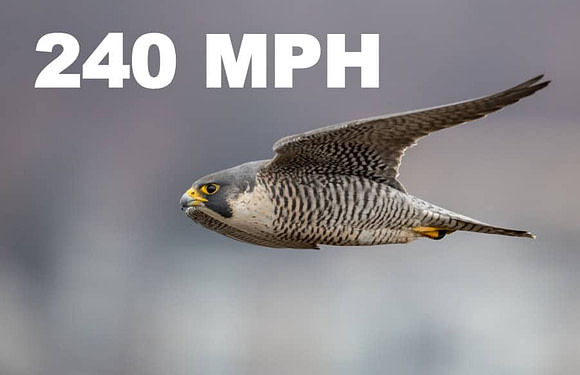
What is a Bird of Prey?
Birds of prey, also known as raptors, encompass a diverse group of birds that share specific predatory characteristics. These birds possess keen eyesight for detecting prey, strong talons for grasping, and sharp beaks for tearing flesh. Scientifically, they belong to the order Accipitriformes, which includes eagles, hawks, and vultures, and the order Falconiformes, which covers falcons.
Birds of prey are carnivorous and found worldwide, inhabiting diverse environments across the globe. Typically, raptors rely on elevated perches or soaring flight to spot prey before swooping down to capture it with great speed and precision. Their dietary habits can range widely from small mammals and birds to fish and carrion, depending on the species.
Largest Eagle That Ever Lived

Once the apex predator of New Zealand, Haast’s Eagle (Harpagornis moorei) had a wingspan estimated to be up to 9.8 feet (3 meters) and weighed approximately 33 pounds (15 kilograms). This massive bird preyed on large flightless birds, especially the moa. Haast’s Eagle ultimately disappeared around 700 years ago, coinciding with the extinction of the moa and human settlement.
The World’s 10 Largest Birds of Prey
1. Andean Condor (Vultur gryphus)

The Andean Condor, native to the mountainous regions of South America, has a wingspan that can reach up to 10.8 feet (3.3 meters), making it one of the largest flying birds in the world. These condors are primarily scavengers, feeding on carrion and playing an important role in their ecosystems by cleaning up after other animals. The significant size of the Andean Condor aids in its ability to fly high above the Andes, utilizing thermal updrafts to glide with minimal energy expenditure. Their black and white plumage is striking against the mountainous backdrop, and they are revered in local cultures as symbols of power and health.
2. California Condor (Gymnogyps californianus)

The California Condor was once on the brink of extinction in the 1980s. With a wingspan of up to 9.5 feet (2.9 meters), this North American bird is one of the largest raptors in the world. It primarily feeds on large carcasses, using its sharp eyesight to spot food from great distances. The California condor was saved by capturing all remaining wild birds, 22 of them, and initiating a captive breeding program. The breeding program, overseen by various zoos and conservation organizations, was very successful in increasing their numbers. There are now approximately 500 California condors in existence.
3. Cinereous Vulture (Aegypius monachus)

Known also as the black vulture, the Cinereous Vulture dominates the skies of Europe and Asia with its wide wingspan of up to 9.8 feet (3 meters). This bird of prey is one of the heaviest and largest raptors, known for its powerful build and ability to locate food over a vast area. The Cinereous Vulture prefers mountainous terrain where it can use thermal currents to glide while searching for food.
4. Lappet-faced Vulture (Torgos tracheliotos)

The Lappet-faced Vulture is recognized for its distinctive fleshy folds of skin (lappets) around its face. It can weigh up to 31 pounds (14 kilograms) and has a wingspan reaching nearly 9.8 feet (3 meters). This vulture is found across much of Africa, particularly in arid and semi-arid regions where it prefers open savannahs, deserts, and other sparse woodlands. It has a strong beak, which is capable of tearing open tough skin and muscle of dead animals that smaller scavengers cannot manage, making it an essential participant in ensuring ecological balance.
5. Martial Eagle (Polemaetus bellicosus)

Africa’s largest eagle, the Martial Eagle, has a wingspan that can exceed 8.5 feet (2.6 meters). With piercing eyes and powerful talons, this eagle is an adept hunter, capable of taking down larger prey such as small antelopes. Their hunting technique is a spectacular dive from great heights, striking prey with immense force. The habitat of the Martial Eagle spans a range from open plains to thick forests. However, they require large territories due to their size and predatory needs, often encompassing up to 130 square miles (340 square kilometers).
6. Steller’s Sea Eagle (Haliaeetus pelagicus)

This formidable raptor, native to the coastal areas of northeastern Asia, is noted for its striking appearance and massive size. With a wingspan of up to 8.2 feet (2.5 meters) and weighing up to 20 pounds (9 kilograms), the Steller’s Sea Eagle is one of the heaviest eagles. It primarily feeds on fish and waterfowl, utilizing its talons to grasp its prey. The bird’s deep vocal calls and bold, piebald plumage make it a spectacular sight in its natural habitat.
7. Harpy Eagle (Harpia harpyja)

The Harpy Eagle stands as one of the largest and most powerful raptors living in the rainforests of Central and South America. This bird boasts an impressive wingspan of up to 7 feet (2.1 meters) and weighs between 10 to 20 pounds (4.5 to 9 kilograms). Its talons are as large as a bear’s claws! Its size and strength enable it to hunt large prey, such as monkeys and sloths. Harpy Eagles possess a gray and black plumage, a broad, muscular build, and a distinctive double crest on the head, which they can raise when threatened or excited.
8. White-tailed Eagle (Haliaeetus albicilla)

The White-tailed Eagle, also known as the Sea Eagle, is among Europe’s largest birds of prey and has a significant presence across various parts of Asia as well. These birds have a wingspan ranging from 6.6 to 8 feet (2 to 2.45 meters) and weigh between 7.9 and 15 pounds (3.6 to 6.8 kilograms). They are easily identifiable by their sizeable yellow beak, pale head, and its broad, white tail contrasting against a brown body. White-tailed Eagles are known for their remarkable agility in the air despite their size. They feed primarily on fish, but their diet is opportunistic and can also include birds and small mammals.
9. Golden Eagle (Aquila chrysaetos)

The Golden Eagle is one of the best-known birds of prey and a revered figure in various cultures. These raptors typically weigh between 6.6 and 15 pounds (3 to 6.8 kilograms) and have a wingspan ranging from 6 to 7.5 feet (1.8 to 2.3 meters). Adapted to a wide range of habitats, these eagles are found in North America, Europe, and Asia, inhabiting mountains, cliffs, and even desolate tundras. They are apex predators, primarily hunting small to medium-sized mammals, such as rabbits, hares, squirrels, and even young deer. In Mongolia, golden eagles are used by the Kazakh in the ancient practice of hunting small game such as foxes and hares.
10. Wedge-tailed Eagle (Aquila audax)

The Wedge-tailed Eagle is a distinctive bird of prey native to Australia. This eagle is the largest raptor in Australia and is easily recognized by its long, wedge-shaped tail. Adults can reach a size of about 3.5 to 4.3 feet (1.06 to 1.3 meters) in length, with a wingspan stretching from 7.5 to 9.5 feet (2.3 to 2.9 meters), making it one of the largest eagles globally. The Wedge-tailed Eagle typically feeds on rabbits, hares, and other small to medium-sized mammals, although it is also known to take down larger prey such as kangaroos, especially in areas where smaller prey is scarce.




























































